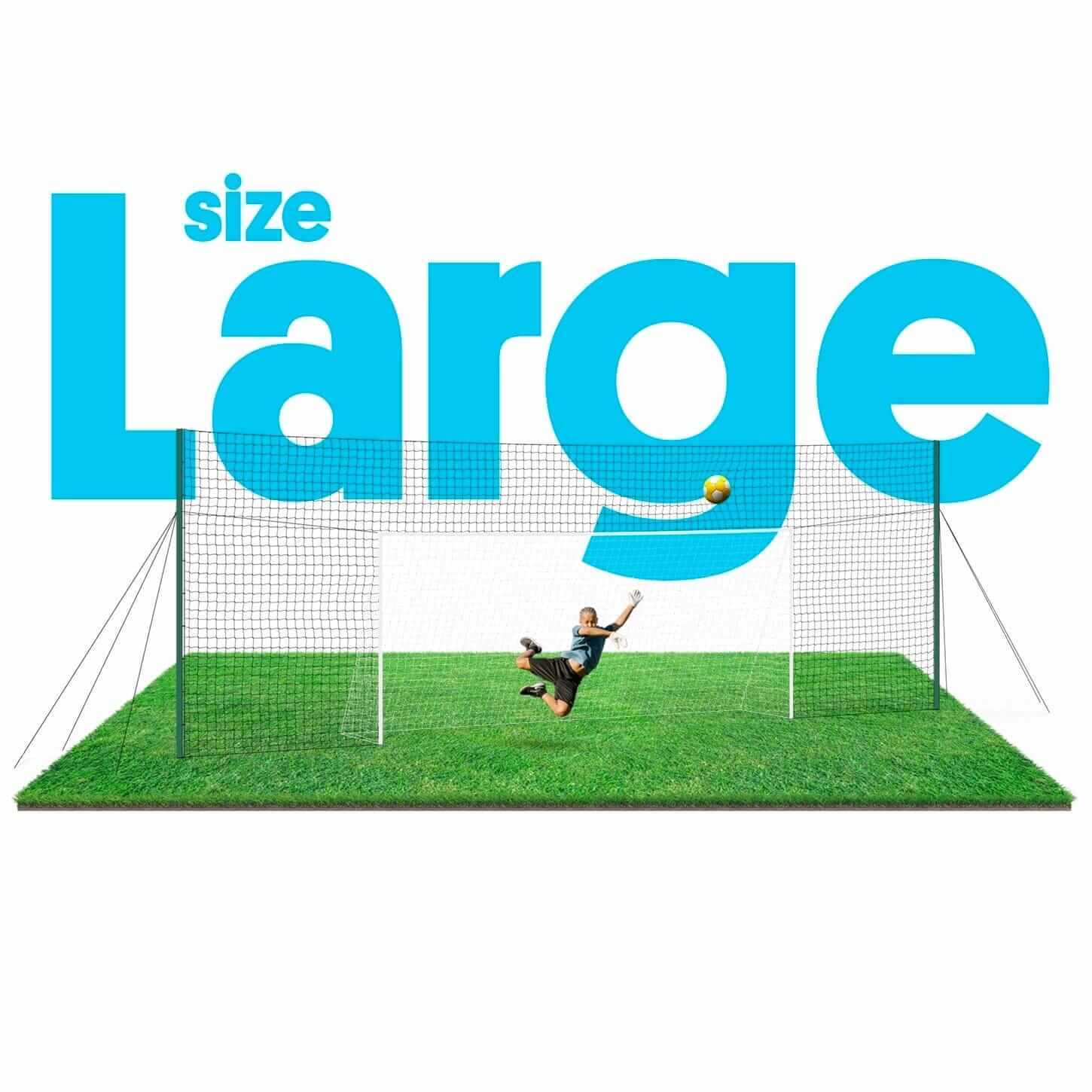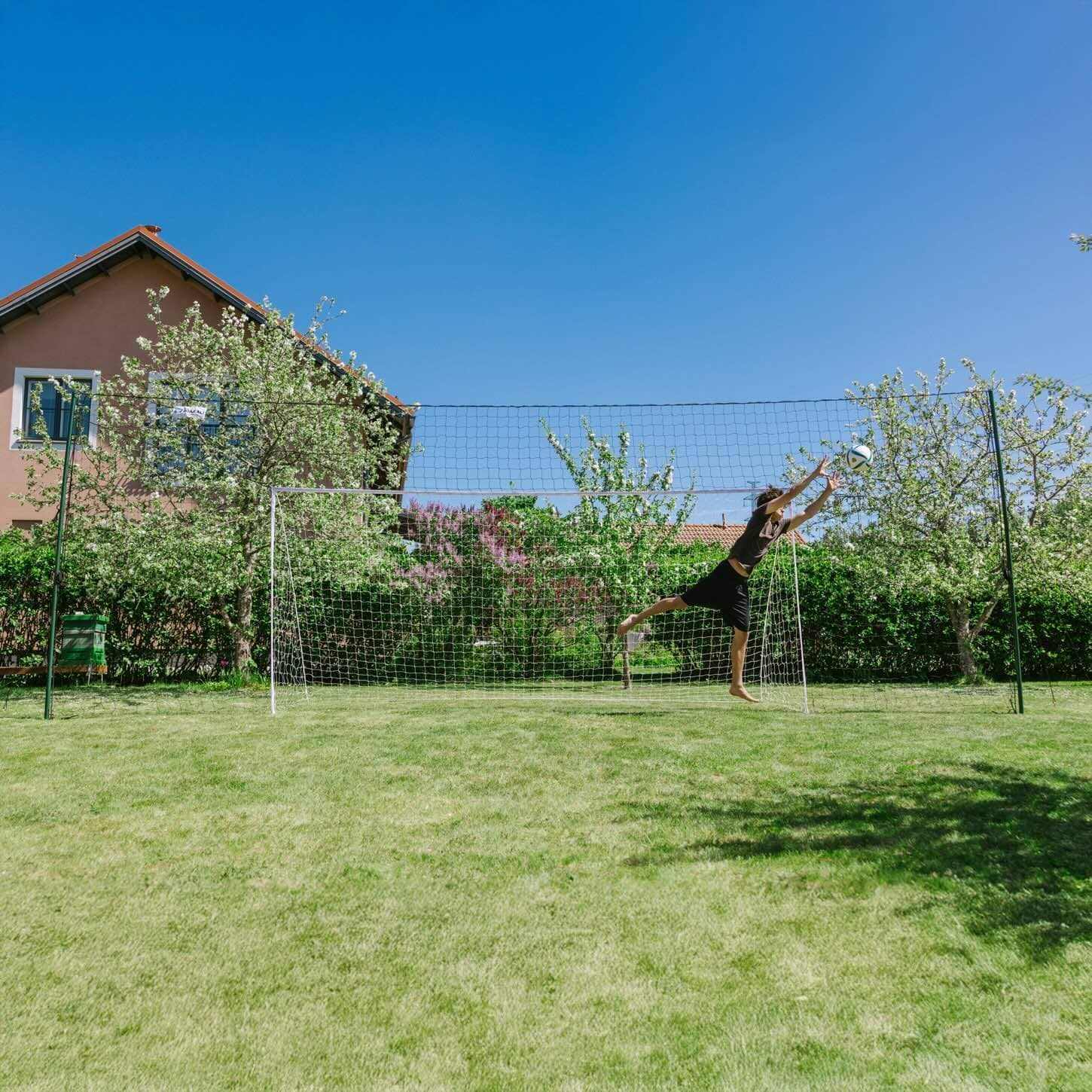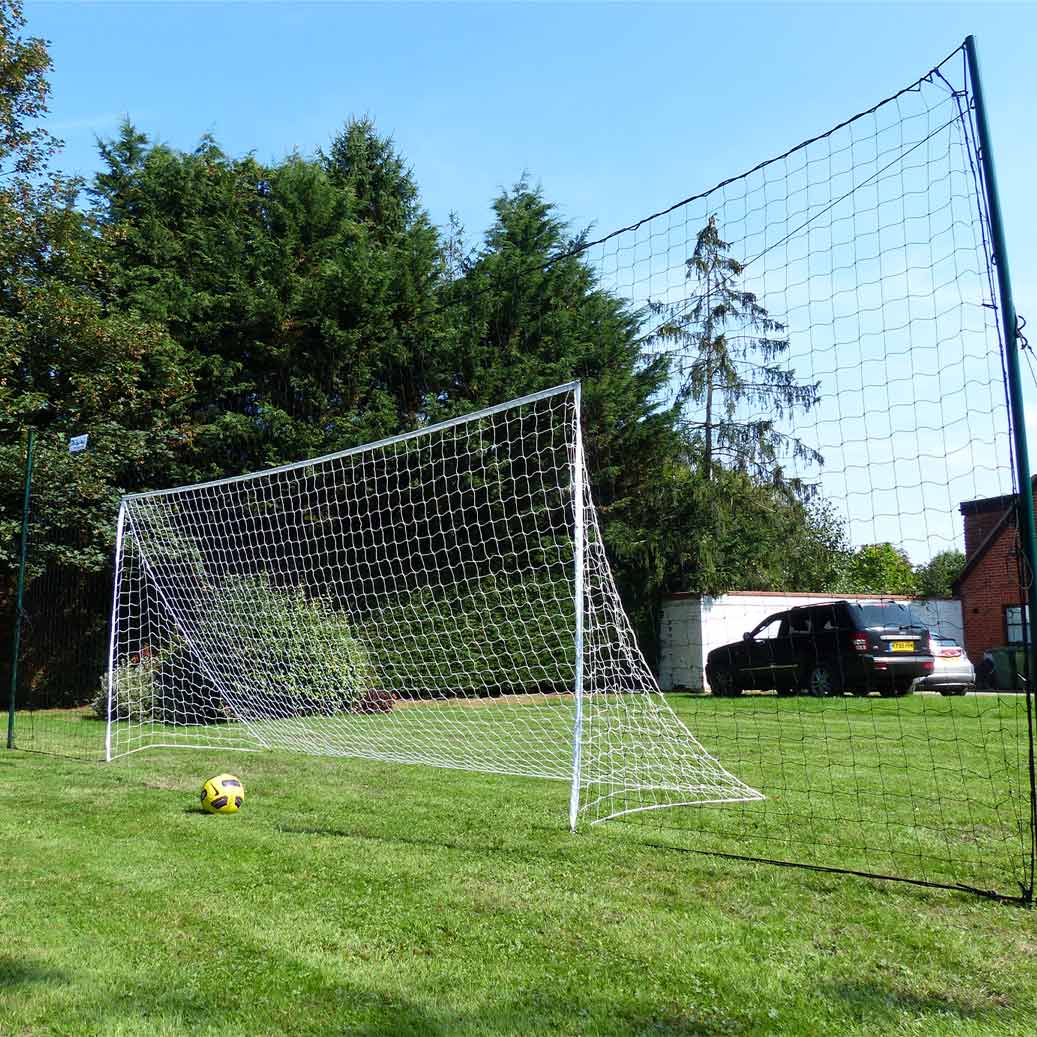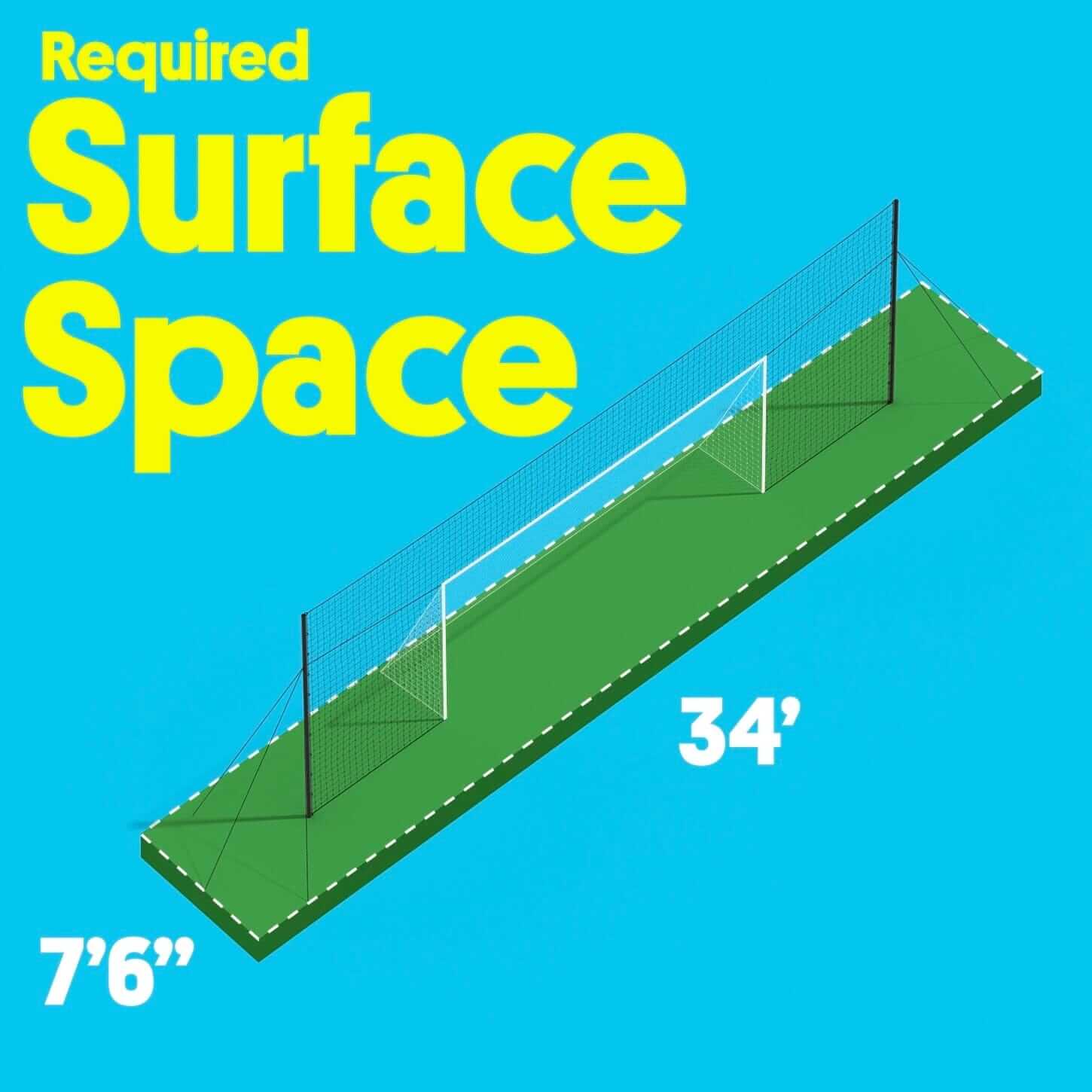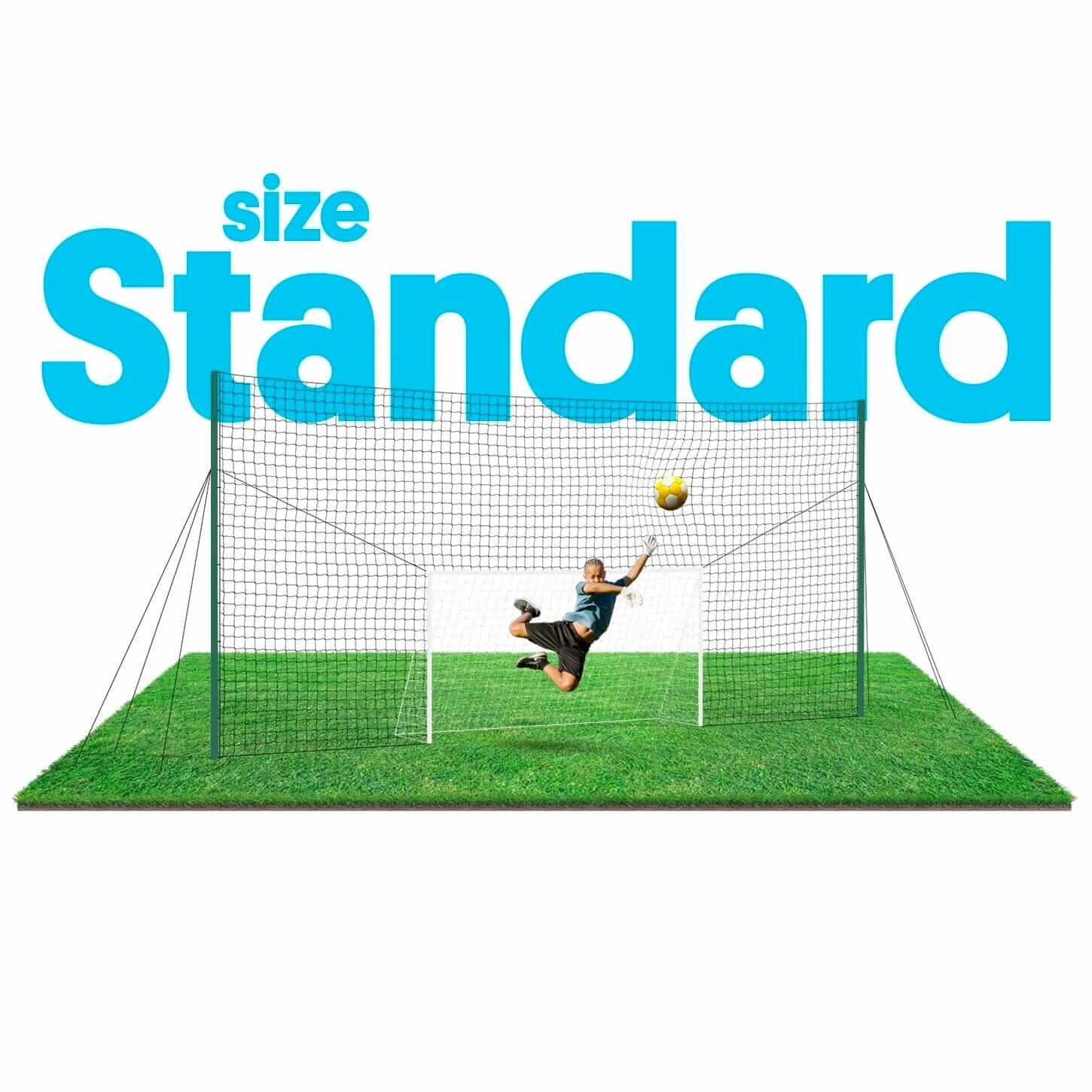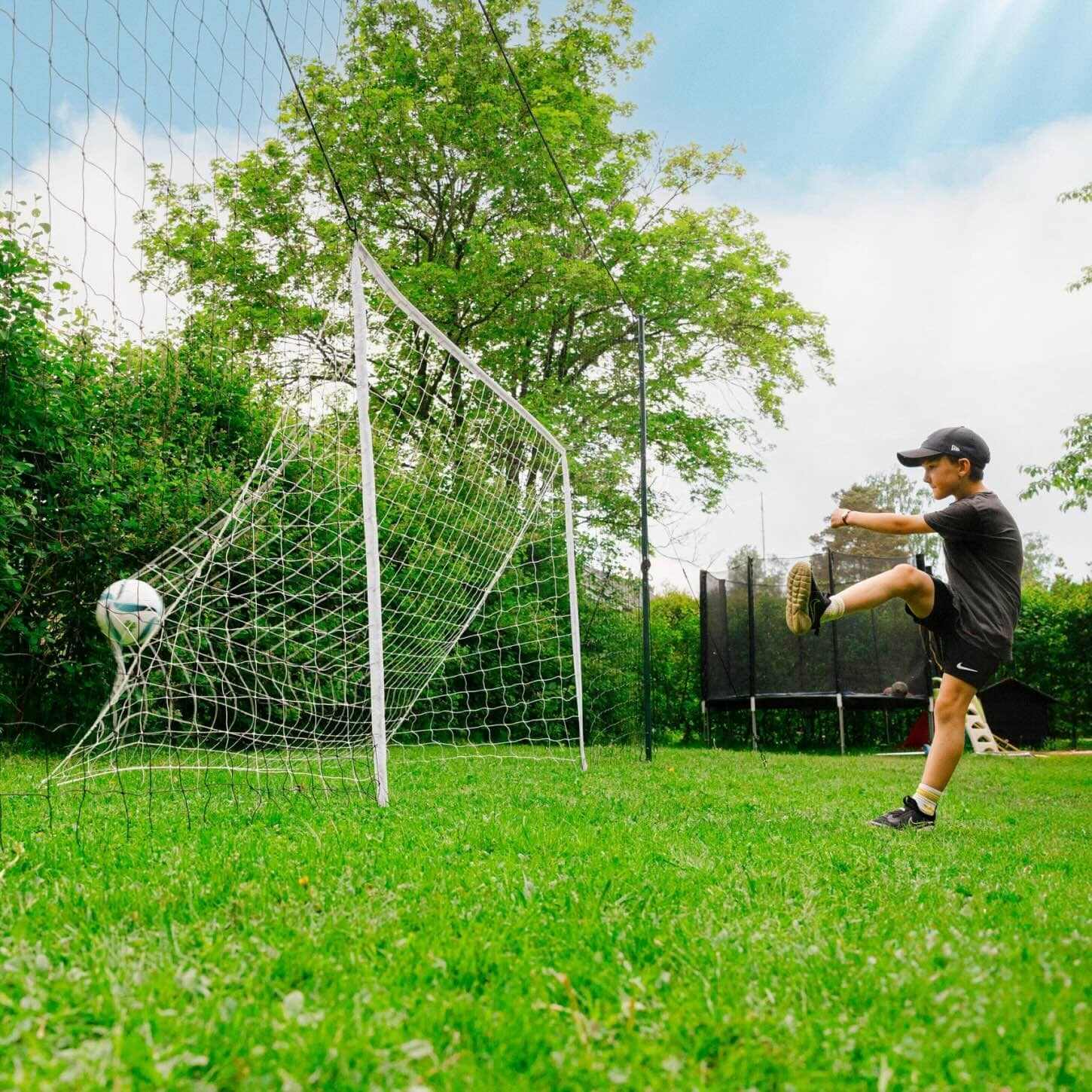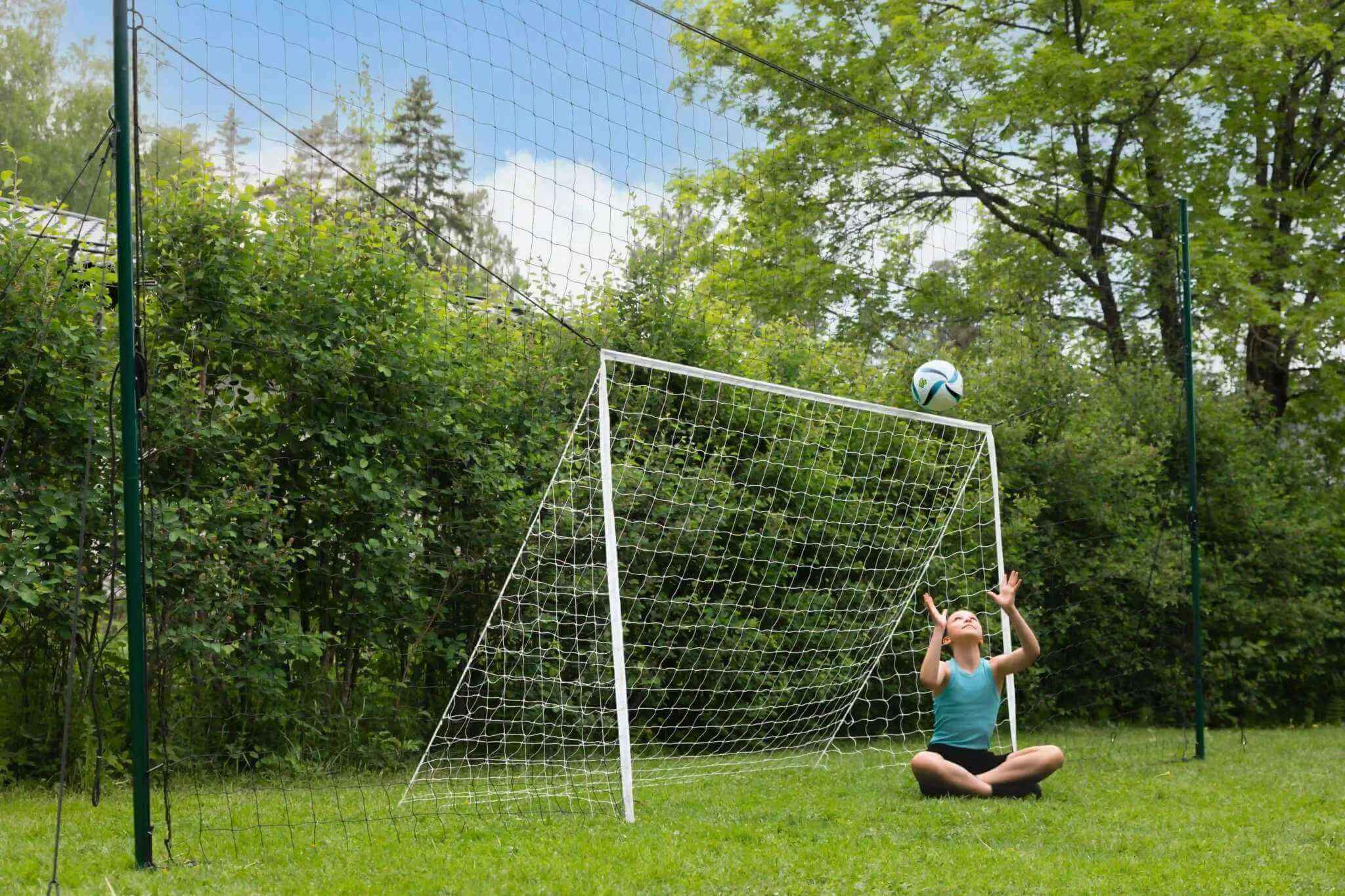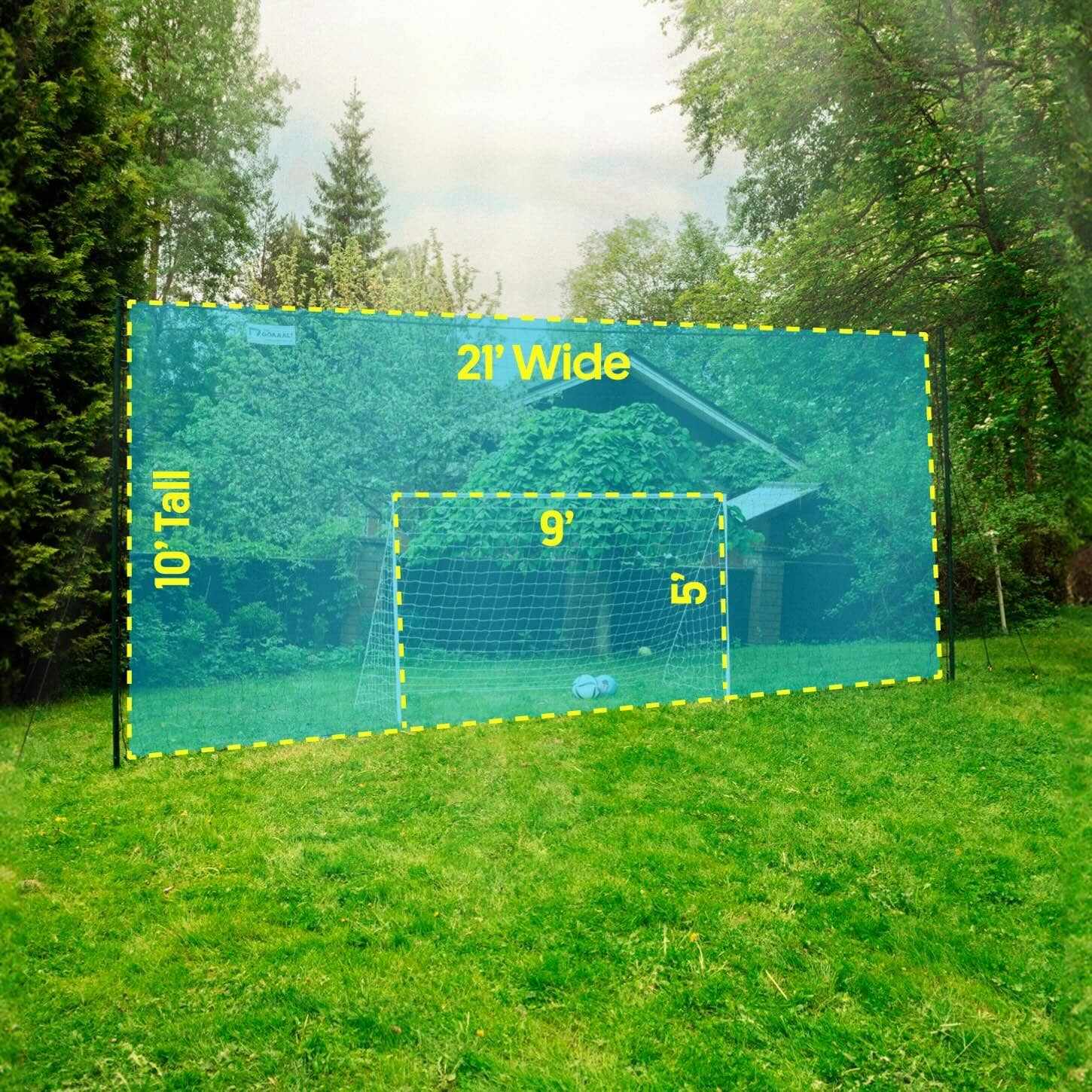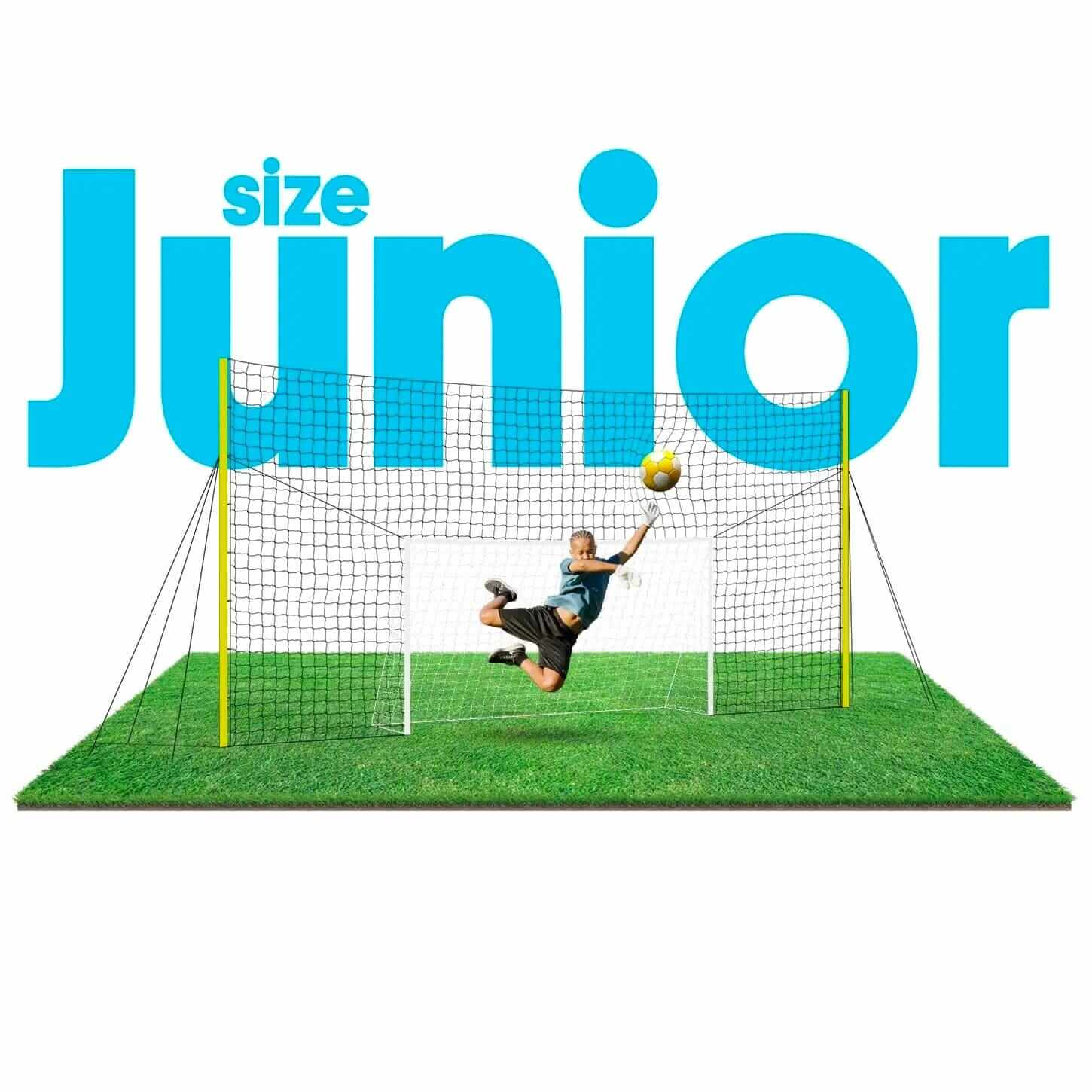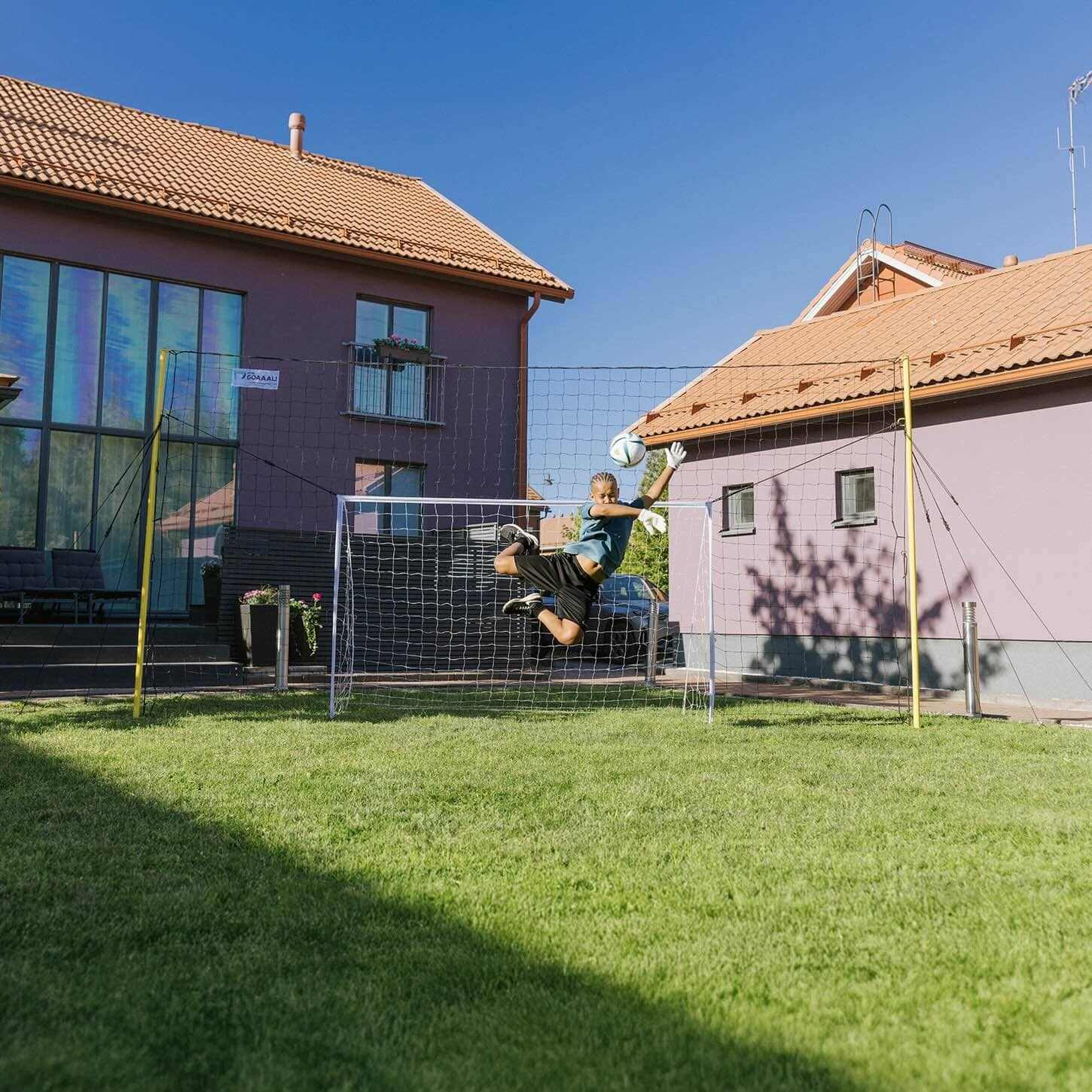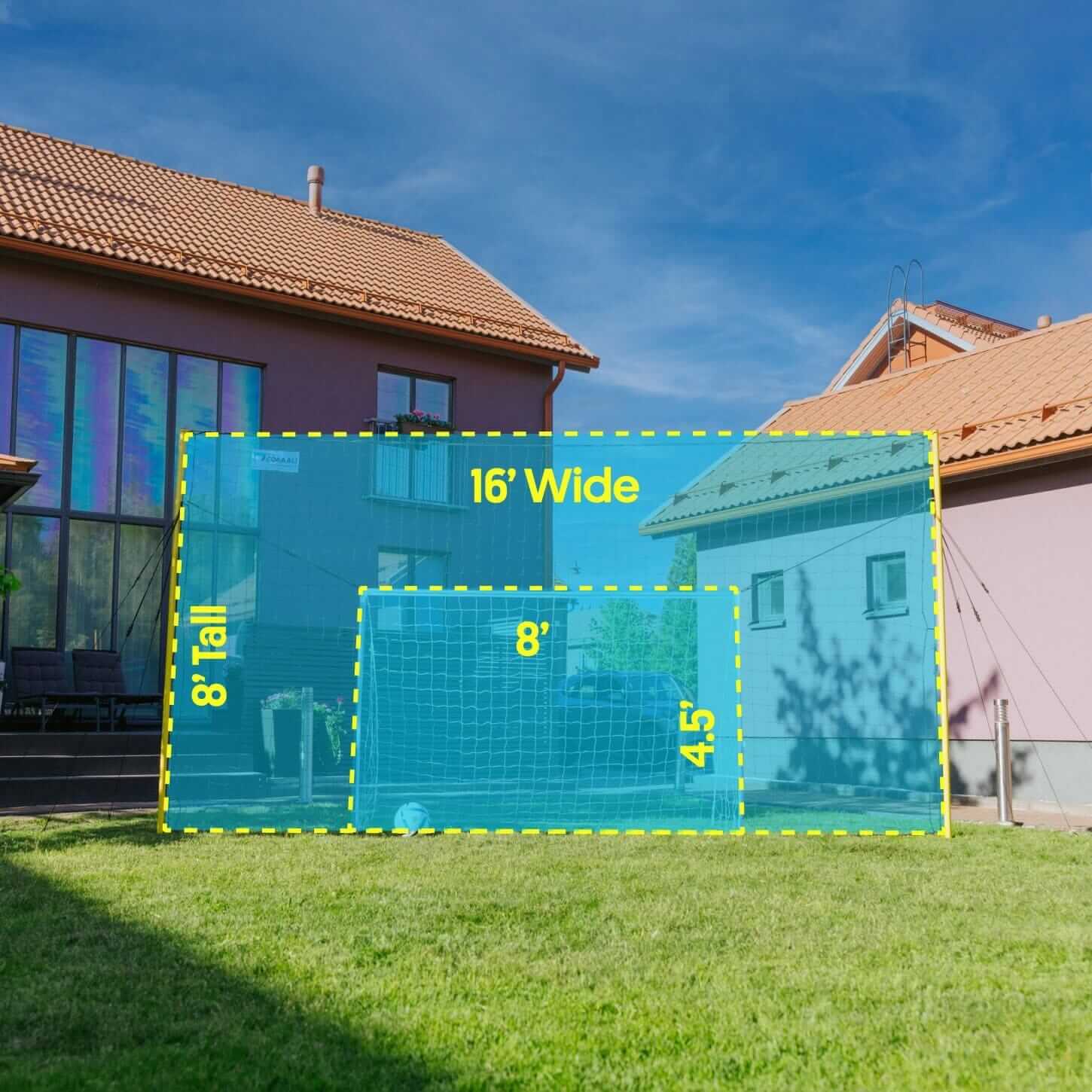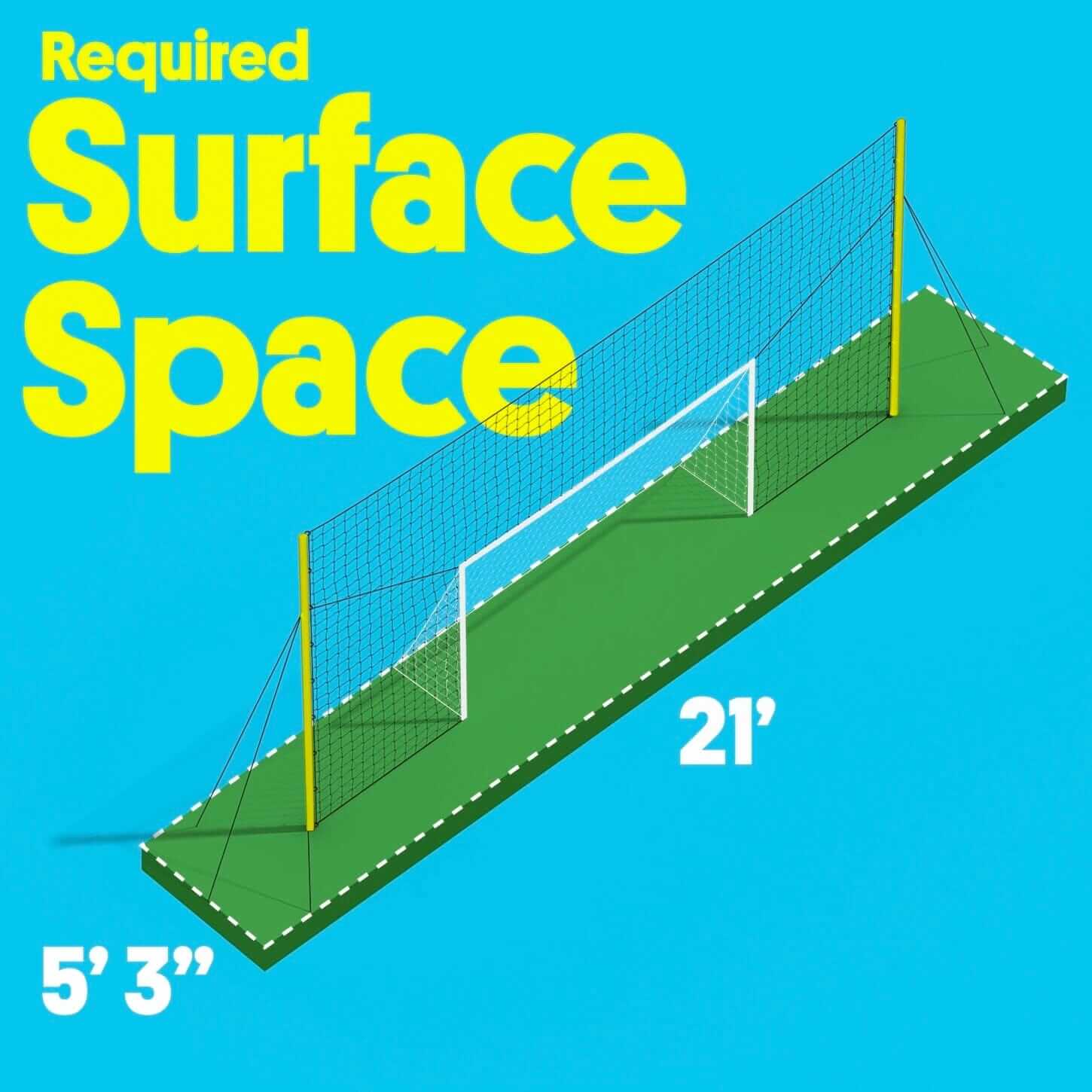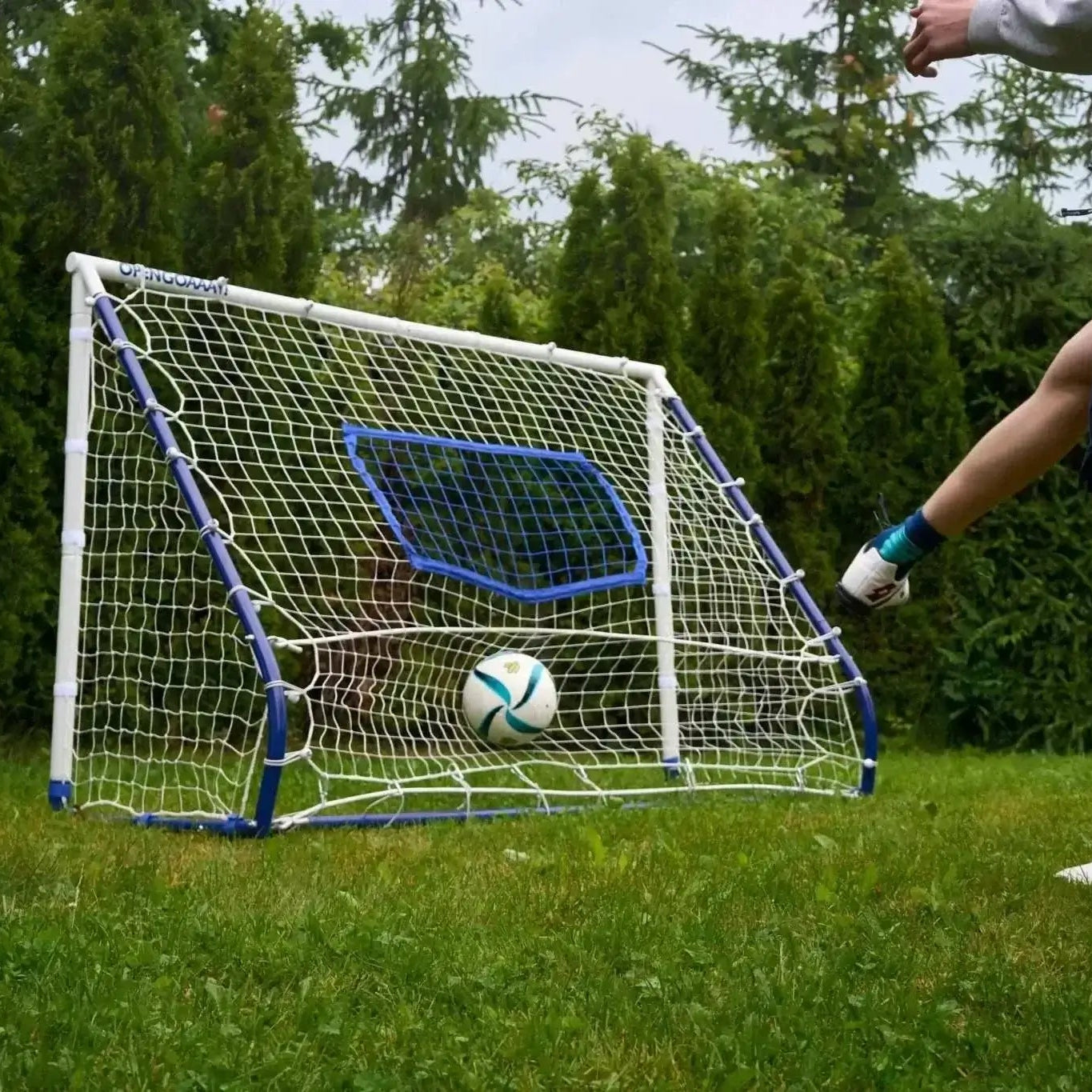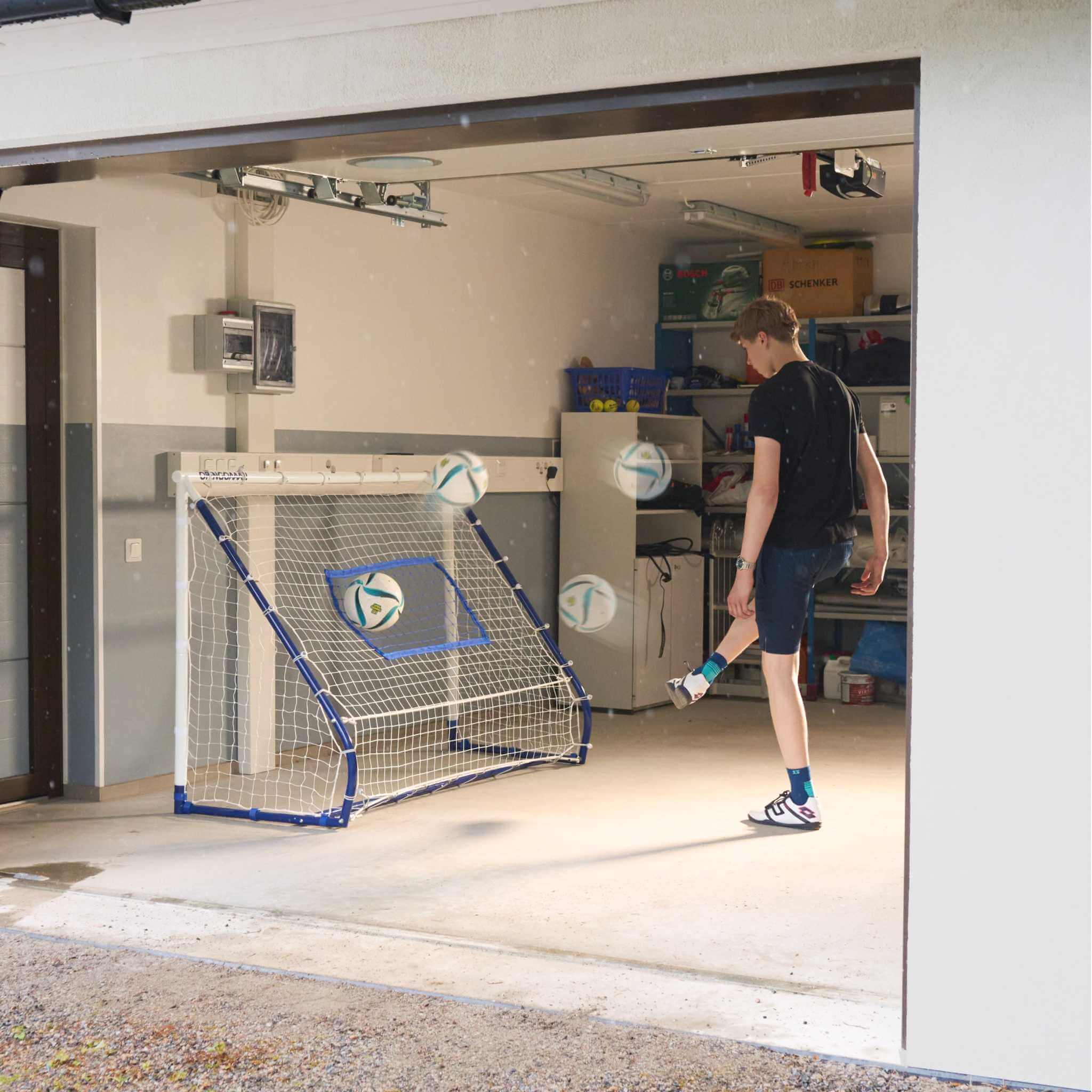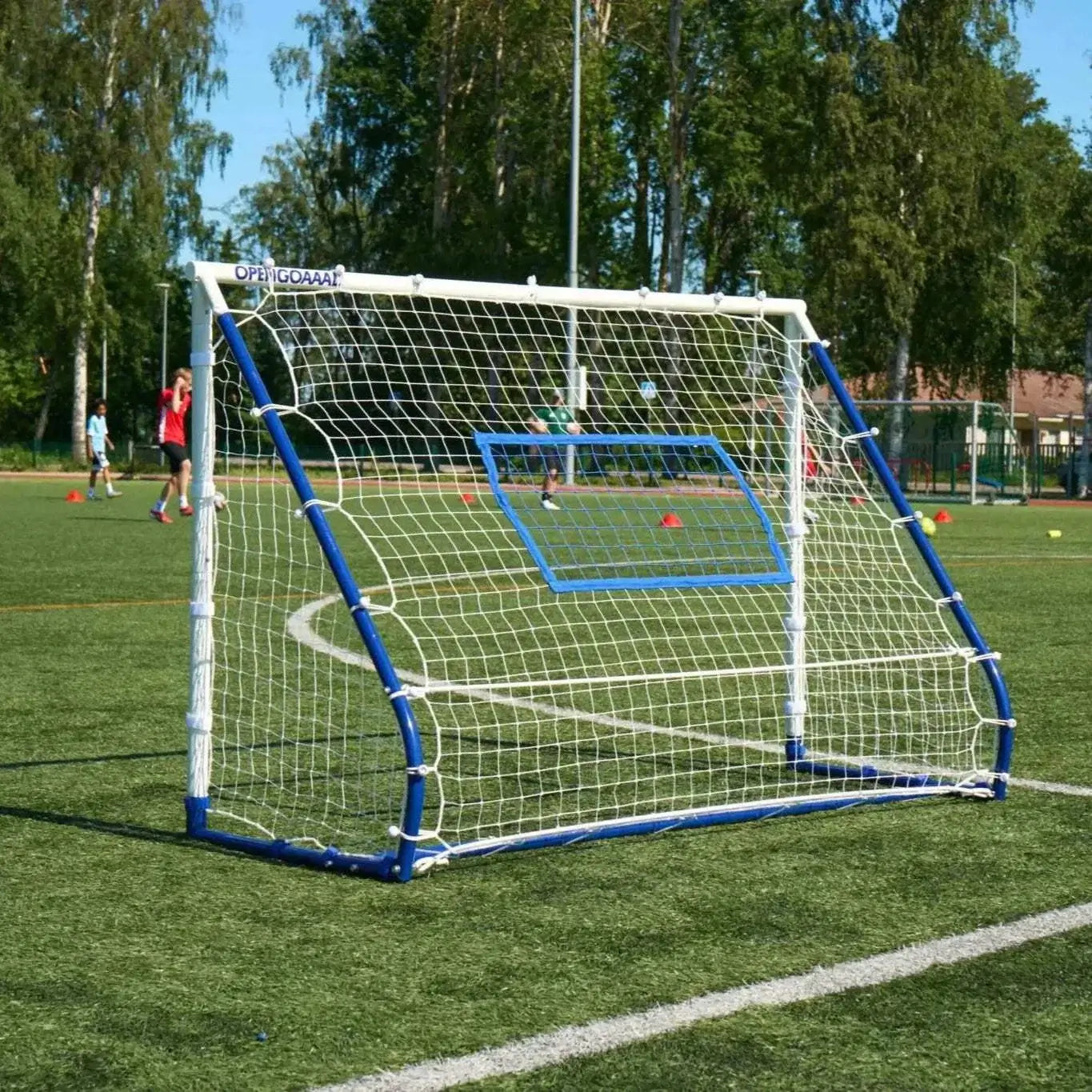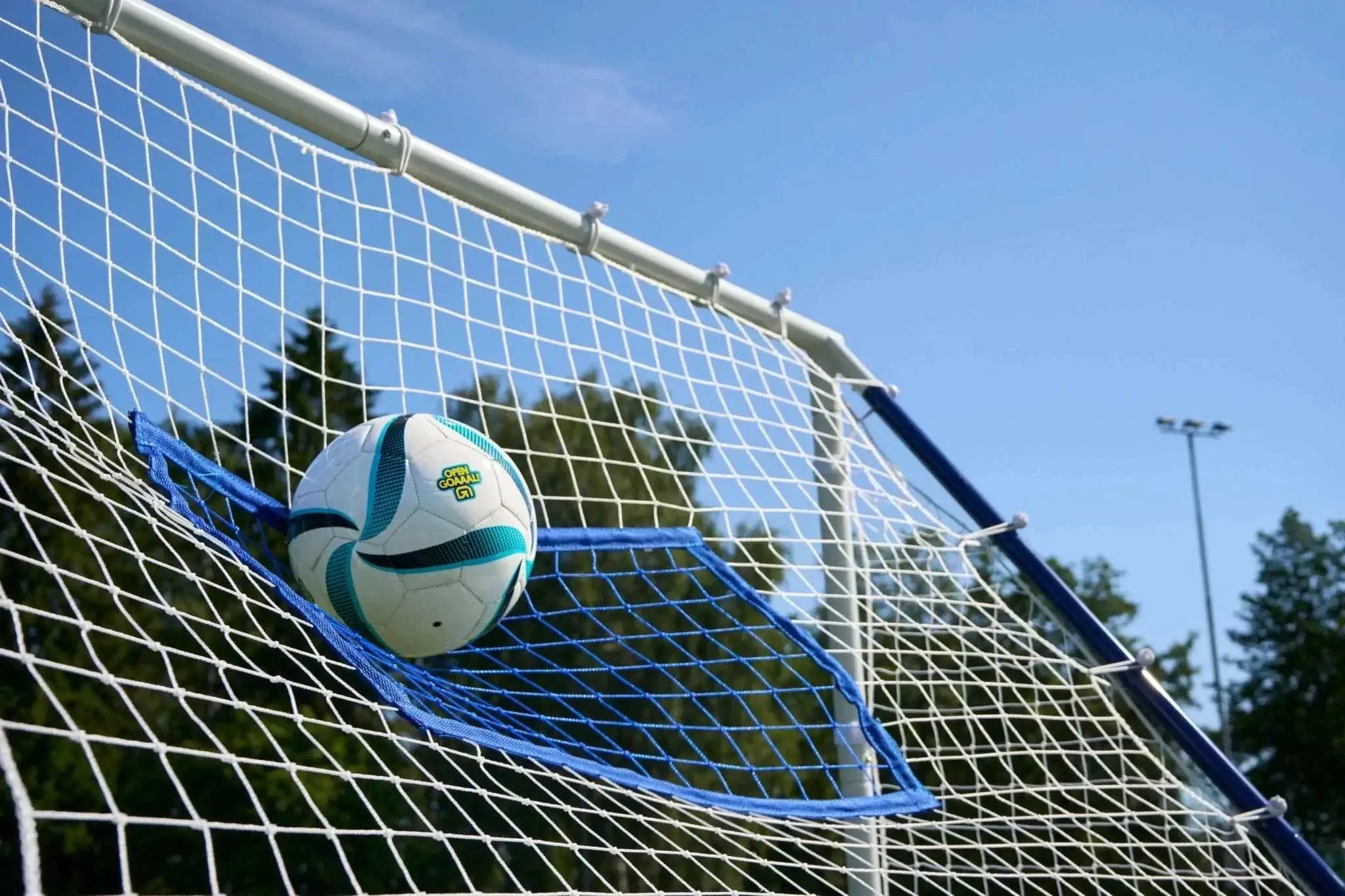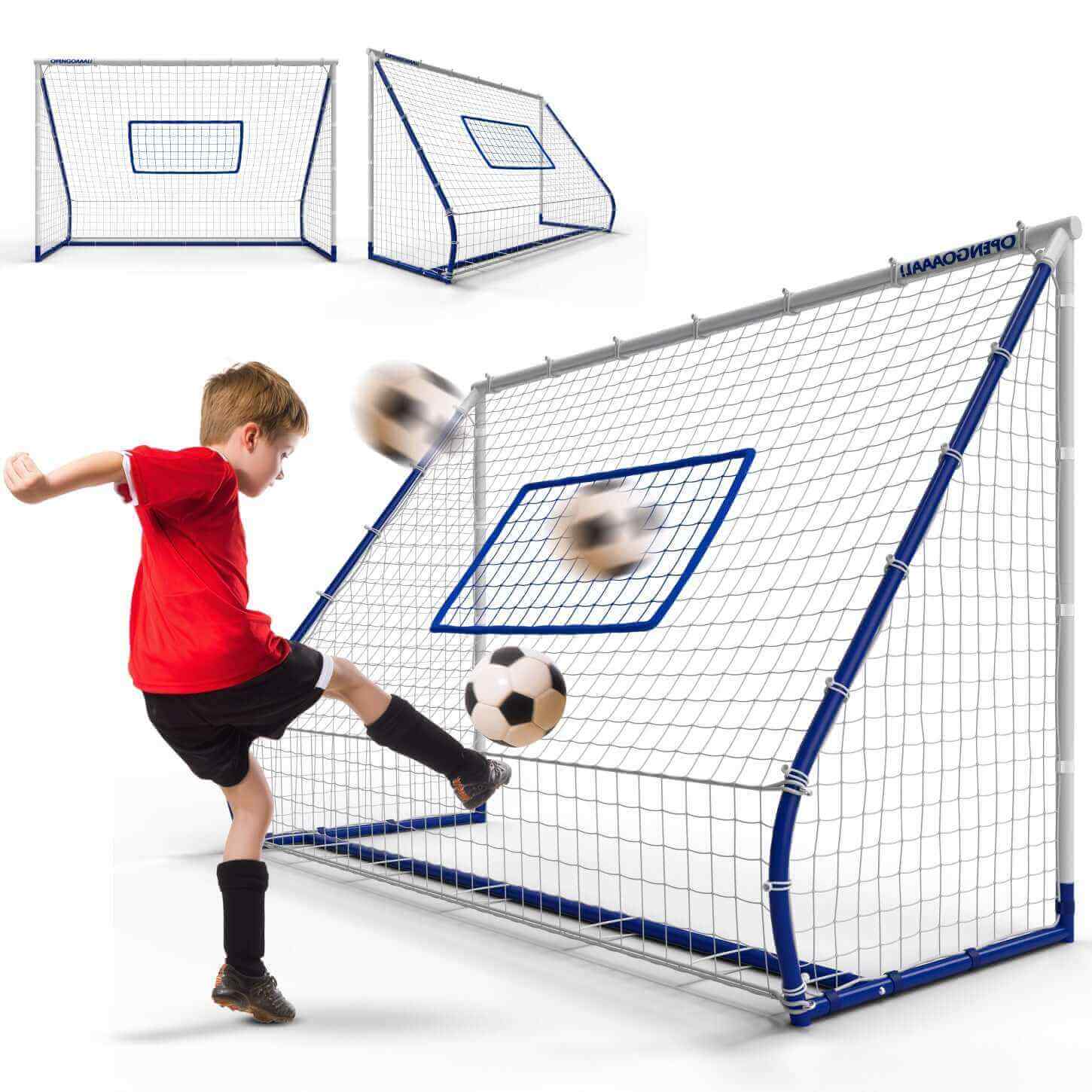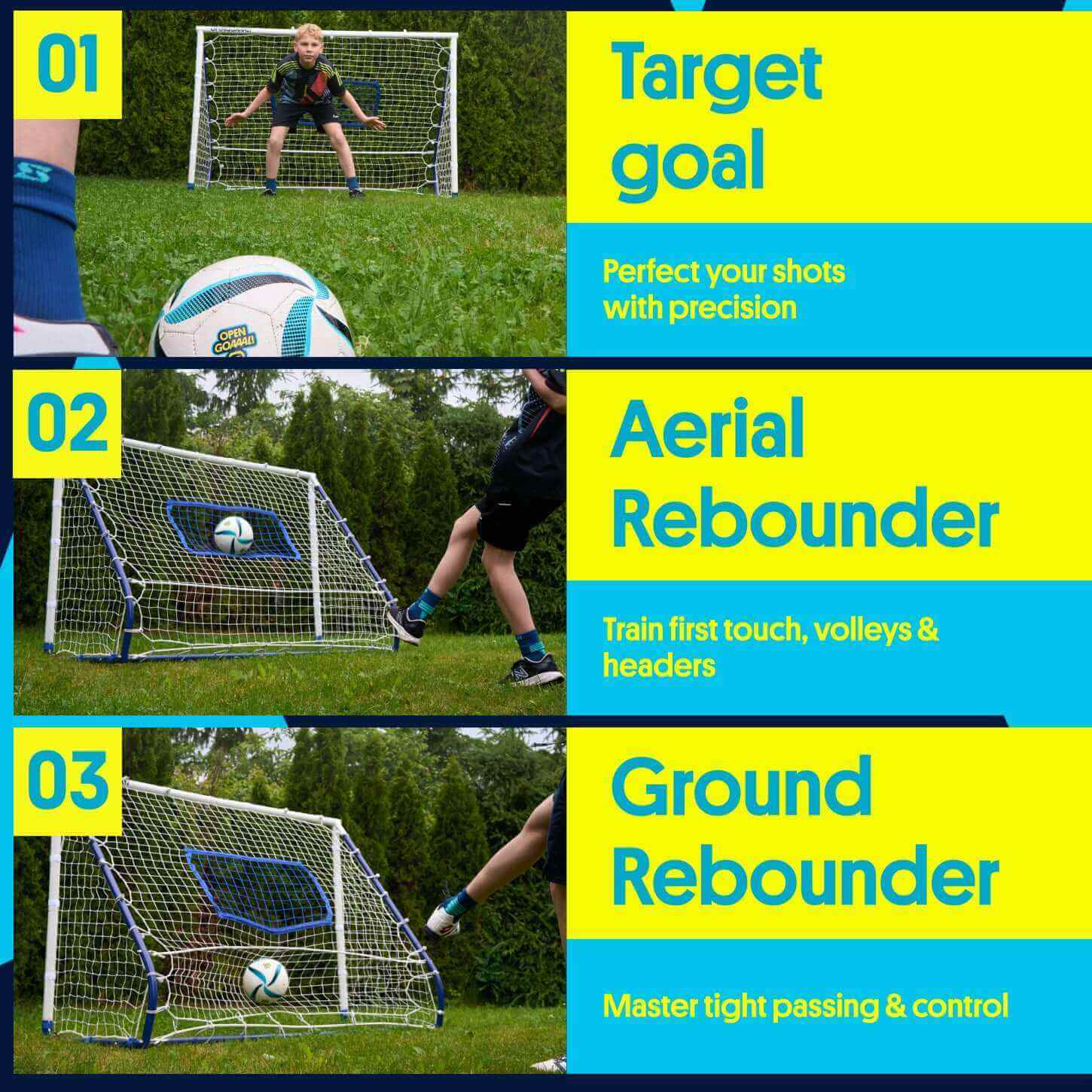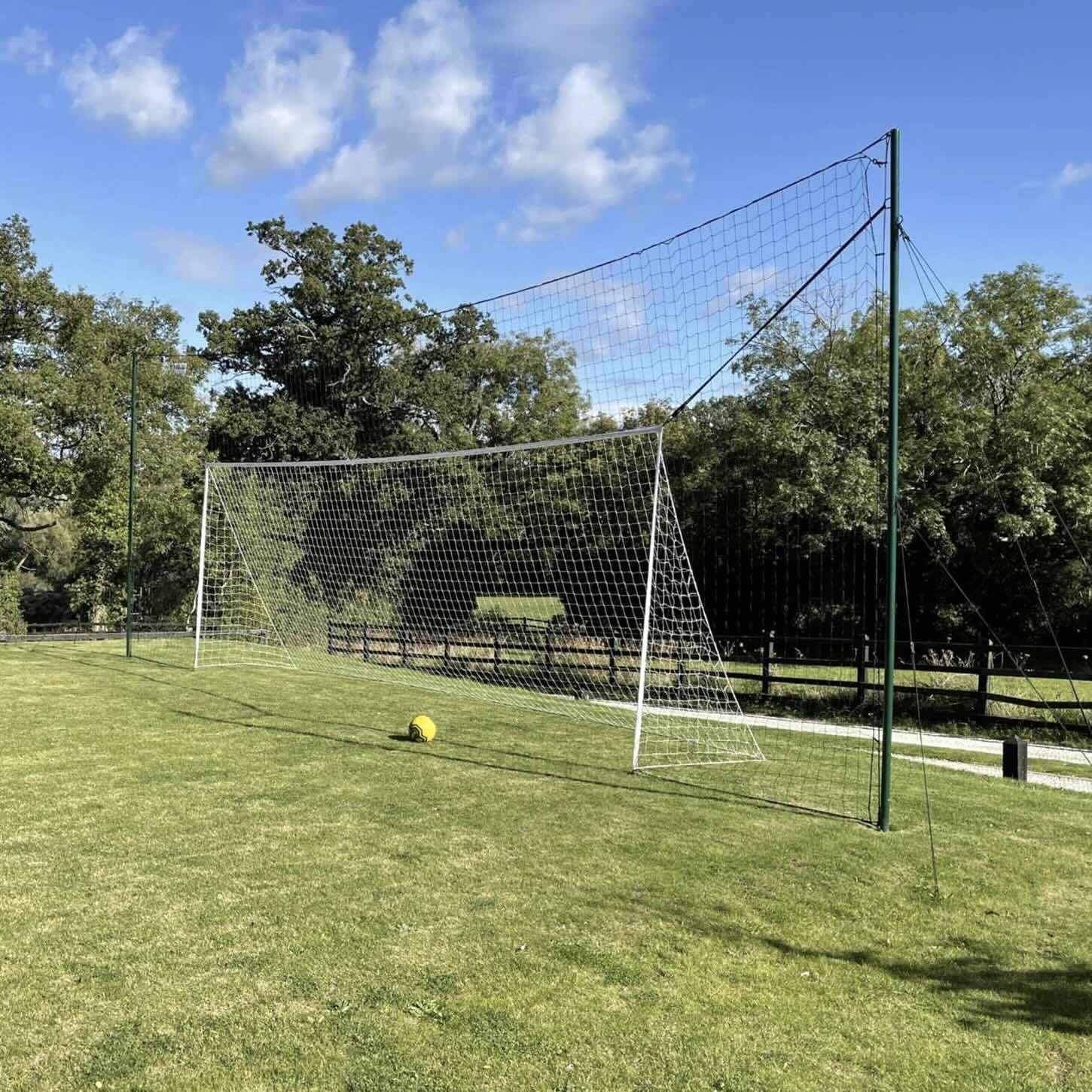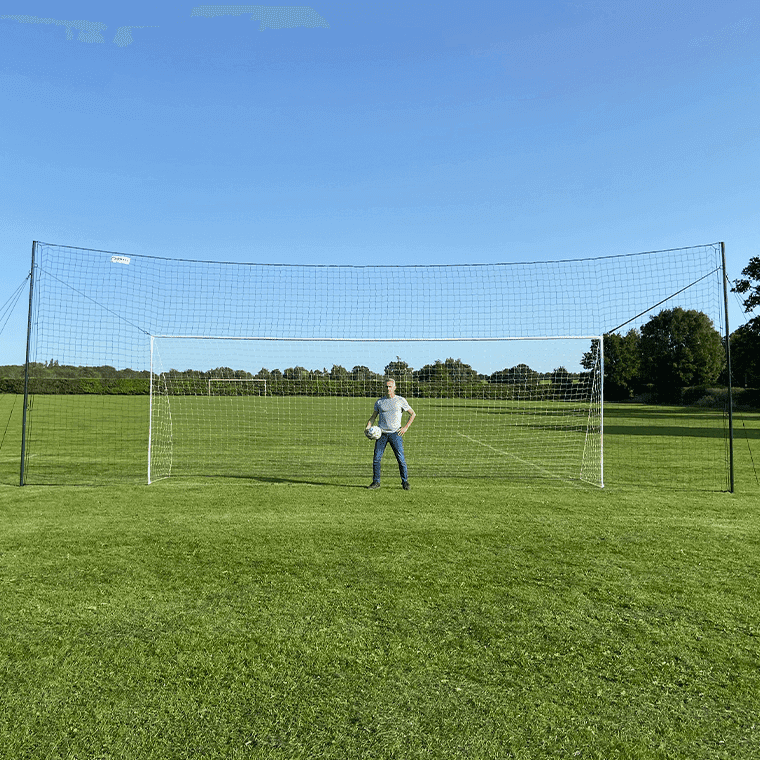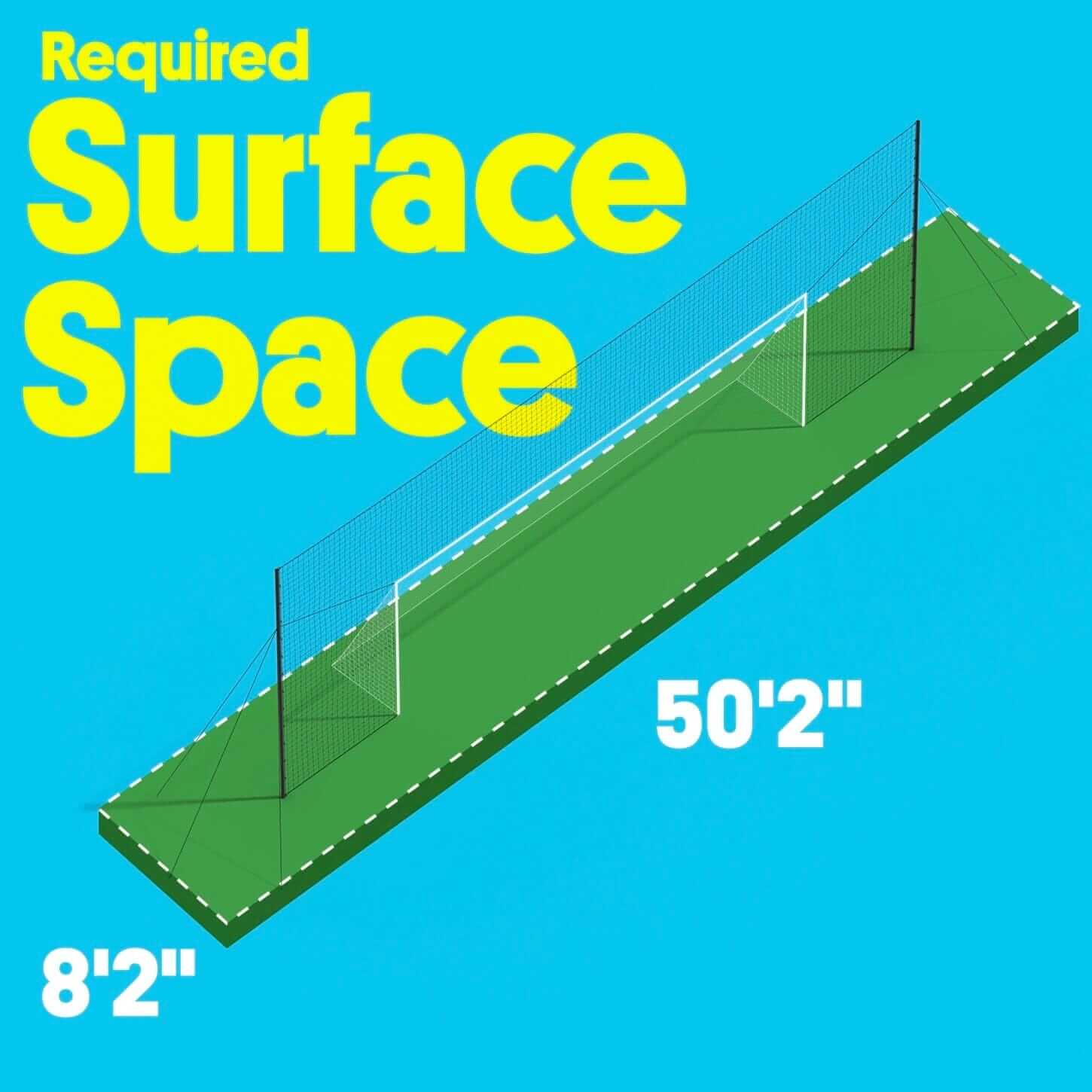Being a soccer goalkeeper is a tough task. Goalies need to be alert and agile while keeping a constant focus on the ball. Moreover, goalies also require a fast reaction time and have to make split-second decisions.
That means their training needs are different from the other soccer players. For this reason, you need to use special goalie drills to train your goalkeepers and help them improve.
These drills will recreate the actual intensity of a real match and help to improve the techniques, speed, reflexes, and fitness of the goalkeepers.
7 Soccer Goalkeeper Training Drills
We have chosen 7 effective goalkeeper training drills that are the best options for young players.
1. Deflect and Dive
This goalie training drill is all about practicing deflecting the ball and diving. The drill requires a full-size goal and a number of footballs.
To start with, the goalkeeper should be ready on the goal line at the center. You will also need two other players who will make use of the soccer balls. Two of the players will stand in front of the goal with the footballs.
The drill begins with one player throwing or shooting a low ball toward one end of the goal. The goalies will move and dive to block the ball.
Once the ball gets blocked, the other player will throw a high ball to the opposite side of the goal. The goalie will need to move fast to catch or deflect that ball. This completes one repetition of the drill.
Each goalkeeper should complete 5 to 6 repetitions. You can increase the time gap between two consecutive reparations depending on the age and fitness level of the goalie. If the goalie is fit enough, there should be no time gap between the drills.
To make the practice more intense, shooters can shoot the ball with their feet instead of throwing it. The power and angular direction of the shots can go up as goalkeepers improve their skills and fitness.

Objective
The main purpose of this training session is to quicken the reaction time of goalkeepers. This allows them to move back into position quickly after a save. The practice also helps them to deal with two attacks from the same move more effectively.
Beyond that, the drill helps to improve footwork and perfect the art of diving. The goalkeepers should learn to land on their hips and put their entire body behind the ball for effective blocking. Additionally, the drill helps to improve the overall fitness levels of the goalkeeper.
2. Agility Hands
This drill needs a few more items apart from a full-size goal and a few soccer balls. You will also need two more players working as servers. While it is best to use a goal for this drill, you can also set it up without one.
Firstly, you need to set up a series of cones in front of the goal. After the series of cones, set up two mannequins, keeping a distance of 6 to 7 yards between them. The two servers should stand around 5 yards in front of the mannequins. In place of mannequins, you can use cones to mark these positions.
The drill starts with the goalkeeper moving quickly through the cones and coming to rest beside one mannequin.
The first server throws or kicks a ball toward the goalkeeper’s chest. The goalkeeper makes a catch, passes the ball back to the server, and moves beside the second mannequin. The process is repeated with the second server.
Once the catching is complete, the goalkeeper runs back to the goal line through the cones. This completes one cycle of the drill. Usually, this goalkeeper drill continues until each goalkeeper completes 10 to 12 catches
To make things more challenging, the servers can pass the ball wide or throw it high up. So, the goalkeeper has to dive or jump to catch it. You can vary the arrangement and number of cones to change the running pattern.

Objective
The main objective of the drill is to improve the agility of a goalkeeper and also to provide the necessary catching practice. This can work as a warm-up drill before a match.
The drill trains the method of positioning the body behind the ball as a barrier. You can also focus on the correct “scooping” technique of using the palms and elbows in the right manner that allows the ball to roll smoothly into the body.
3. Three Cone Drill
While this is a relatively simple drill, it is a great choice for a goalie practice session.
To start, set up three cones 8 to 10 feet in front of the goal line. Ideally, the three cones should be of three different colors. Another player stands at the penalty spot to make the shots with the football.
As the goalkeeper stands at the center in a ready position, the partner yells out a cone of a specific color. The goalkeeper runs to that cone and back in position at the goal center. At this time the partner takes a shot at the goal. The goalkeeper should attempt to block the shot.
The pace of the game can be increased by giving the goalie less time to take a position. Also, a combination of high and low shots should be made to help improve goalie skills.

Objective
This is a great drill to strengthen the foundations of goaltending. That involves making quick changes in direction and regaining position for effective blocking. It helps to improve footwork and trains the goalie to move fast between the goalposts.
For advanced goalkeepers, the speed and angle of the shots can be varied to make them think and react more quickly. It will also train the goalkeepers to lean forward and always remain on their toes to make a fast move.
4. Goalie Wars
This is a competitive goalkeeper training drill where two goalkeepers play against each other in an attempt to score. You can start by creating a 20x15 playing zone by using cones. Place two goals at two ends of the zone along with a number of footballs at each end.
Next, mark “goalie zones” for each goal by placing a cone at a distance of 5 yards from the goal lines. Both goalkeepers will make their attempts from inside these zones.
The drill starts with one of the goalkeepers throwing, kicking, or volleying the ball to the other goal to score a goal. The defending goalkeeper makes all the necessary attempts to score.
If the defending goalkeeper is able to block, they can start with their attempt to score with a ball from their end. If the attacking goalkeeper scores, they can continue their attempts at the goal.
You can set a time limit or a score limit for each round of the drill. If there are more than two goalkeepers, rotate them after every round.

Objective
With the attacking goalkeeper shooting or throwing the ball from different angles, the defending goalkeeper gets to learn about reacting quickly while handling incoming balls. The right competitive spirit also makes the game more intense and helps to increase the confidence of the goalies.
5. Move with the Ball
This goalie drill involves the goalkeeper and five other players. Let the field players spread out within the penalty area and keep a supply of balls behind them. If there are fewer than five players, you can spread them around the goal to create more space.
The players start by passing the ball among themselves. After four passes, a player can take a shot at the goal. The goalkeeper follows the ball constantly and attempts to make a save when a player shoots at the goal.
Once an attempt is completed, the players start passing around with the next ball. The goalkeeper gets back into position and the cycle is repeated 5 to 6 times.
Ideally, the server players should attempt to complete the passes and shots with one touch. The faster the ball is passed around the more challenging it becomes for the goalkeeper.

Objective
This drill is a good choice to focus on goalkeeper footwork and also helps them to take up proper positions quickly. The exercise also sharpens a goalkeeper’s ability to react quickly, especially in 1v1 situations.
Goalkeepers need to anticipate the movement of the striker based on their observation. This drill helps them to keep their focus on the ball by following the touches and passing action.
6. One Cone Drill
The aim of the one-cone drill is to simulate a situation when a goalkeeper needs to change direction quickly. The setup involves placing a cone in line with the goal center, a few yards ahead of the goal line. A server player stands with a few footballs in the corner of the penalty area.
The goalkeeper starts the movement by running towards the cone, imagining it as an attacking striker. They run around the cone and come back to the goal line to defend the shot the other player makes at the goal.
The other player can be placed in various positions to practice defending incoming shots from all angles. Also, the server player needs to mix it up and make both low and high shots at the goal.

Objective
During a match, the direction of an incoming ball can change at any moment. If the initial anticipation is incorrect, the goalkeeper needs to make fast turns and reorient their body to defend the goal.
This drill helps the goalie stay alert and reposition their body based on the ball's location and the shooting angle. This also prepares them to adjust their position and narrow the angle by spreading themselves.
7. Low Diving Drill
As the name indicates, this goalie drill is for practicing the low diving skills that are crucial during a match.
You need a shooter and a goalkeeper for this practice. The goalkeeper stands at the center of the goal line while the other player stands at the penalty spots. The player starts by making a low shot toward one side of the goal. The goalkeeper dives low to catch the ball and then gets back into position.
The next shot is directed toward the opposite side of the goal. The drill continues for a specified time limit and alters between the left and right sides.
Objective
This drill helps young goalkeepers to master the art of diving to catch a fast-moving ball at the ground level. A correct dive is a combination of good technique, a wide stance, and quick reaction time which needs practice. A typical ground dive is made parallel to the ground without gaining much height and requires a burst of speed.
In addition, it also helps goalies to perfect their landing. Ideally, they should practice lading on the hips and shoulders to prevent injury to the more vulnerable parts of the body.
The Purpose of Goalie Drills
It is evident that the practice needed for goalkeepers is different from that of outfield players.
Anyone familiar with soccer fundamentals will know that even the best goalkeepers perform less sprinting and explosive action than the rest of the team. So, a one-size-fits-all approach cannot be the ideal soccer coaching plan for both groups of players.
Two primary movements that goalkeepers need to practice are forward and lateral running. One primary focus of the goalie drills should be on short-distance fast-acceleration speed training. However, do not forget to include long-distance sprints in the training plan.
The next set of important movements includes diving and high ball jumping which are essential for making a save.
For this aspect, the focus should be on bilateral training or training that involves both sides of the body. The training also involves improving reaction time to ensure a quick response to a fast-moving striker.
Note, both jumping and diving need explosive force generation by the lower body muscles. So, in addition to the general conditioning and goalie training drills, power training is also necessary to strengthen these muscles. With stronger muscles, a goalie can make a powerful take-off.
In the next stage, goalkeepers need to have the necessary upper body strength to tackle crowded conditions within the penalty area.
During some set pieces, there can be multiple opponents around, obstructing free movement. So, the goalkeeper will need the necessary strength and agility to handle such chaotic scenarios.
Final Thoughts
While goalkeepers are not necessarily the focus of a soccer game, their actions can decide the results of a game within a few seconds.
This makes a set of comprehensive goalie drills a vital part of your soccer practice plans. While focusing on the primary training objectives, don’t forget to get creative and make it a fun session for the young players.
To make your goalkeeper drills more effective, using the Open Goaaal 3-in-1 Rebounder is a great choice. With the rebounder set in the training round, your players need not waste any time chasing down the ball and can improve at a faster rate.


